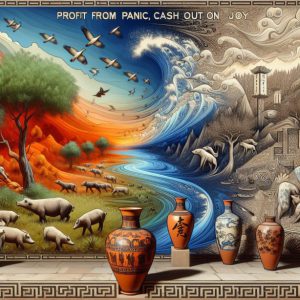
Panic Selling is also known as hitting rock bottom.
June 25, 2024
Few phenomena are as destructive and yet as recurring as panic selling in the ever-volatile world of financial markets. This essay delves into the intricate psychology behind this behaviour, exploring how mass psychology, cognitive biases, and technical analysis interplay to create both peril and opportunity for investors. We’ll uncover timeless truths about human nature and its impact on financial decisions by weaving in wisdom from experts spanning millennia.
The Anatomy of Panic Selling
Panic selling occurs when many investors simultaneously rush to sell their holdings, often triggered by a sudden market downturn or negative news. This behaviour can lead to a vicious cycle, where selling begets more selling, further driving prices down and exacerbating the panic that initiated the sell-off.
As the ancient Chinese philosopher Lao Tzu wisely observed, “He who controls others may be powerful, but he who has mastered himself is mightier still.” This sentiment encapsulates the core challenge investors face during market turmoil – mastering one’s emotions.
Mass Psychology: The Herd Mentality
To understand panic selling, we must first grasp the concept of mass psychology. Gustave Le Bon, a pioneering sociologist, wrote in his 1895 work “The Crowd: A Study of the Popular Mind”:
“In crowds, it is stupidity and not mother wit that is accumulated.”
This insight illuminates how individual rationality can be subsumed by collective irrationality during periods of market stress. When fear grips the masses, even seasoned investors can be swept up in the panic.
Recent research in behavioral finance has further elucidated this phenomenon. A 2021 study published in the Journal of Behavioral and Experimental Finance found that social contagion significantly exacerbates market volatility during crises. The study showed that investors are likelier to sell when they perceive others in their social network to be selling, regardless of the underlying fundamentals.
Cognitive Biases: The Mental Traps
Several cognitive biases contribute to panic selling:
1. Loss Aversion: Psychologists Daniel Kahneman and Amos Tversky’s prospect theory demonstrates that people feel the pain of losses more acutely than the pleasure of equivalent gains. This can lead investors to sell hastily to avoid further losses, even if it means missing out on potential recovery.
2. Recency Bias: Investors tend to overweight recent events in their decision-making. A sharp market decline can lead to the belief that the downtrend will continue indefinitely, ignoring long-term market patterns.
3. Herding Bias: The tendency to follow the crowd can be particularly dangerous in financial markets. As Warren Buffett famously quipped, “Be fearful when others are greedy, and greedy when others are fearful.”
4. Availability Bias: Vivid, easily recalled information (like dramatic news headlines) can disproportionately influence decisions, overshadowing more relevant but less salient data.
Technical Analysis: Reading the Market’s Mood
While cognitive biases and mass psychology explain the emotional drivers of panic selling, technical analysis provides a framework for understanding market dynamics. Key indicators can help investors identify potential panic selling situations:
1. Volume Spikes: Unusually high trading volume often accompanies panic selling episodes.
2. Volatility Indices: The VIX, often called the “fear index,” tends to spike during periods of market stress.
3. Moving Averages: Breaches of long-term moving averages can trigger further selling as they signal a potential change in trend.
4. Relative Strength Index (RSI): Shallow RSI readings can indicate oversold conditions, often present during panic selling.
A 2022 study in the Journal of Financial Economics found that combining technical analysis with measures of investor sentiment can significantly improve the prediction of market turning points, particularly during crisis periods.
Historical Perspectives on Market Panics
“The four most dangerous words in investing are: ‘this time it’s different,'” cautioned Sir John Templeton, the legendary investor known for his contrarian approach. This wisdom reminds us that while the specifics of each market crisis may vary, the underlying human behaviours remain remarkably consistent.
Let’s examine some notable examples of panic selling and the lessons they offer:
1. The Wall Street Crash of 1929
The Great Depression preceded the most infamous stock market crash in history. From September to November 1929, the Dow Jones Industrial Average lost nearly 40% of its value. Panic selling was rampant, with many investors selling at any price to exit the market.
Lesson: The crash highlighted the dangers of excessive speculation and leverage. It also demonstrated how panic selling can turn a market correction into a full-blown crash.
2. Black Monday (1987)
On October 19, 1987, global stock markets crashed, with the Dow Jones falling 22.6% in a single day. Program trading and portfolio insurance strategies exacerbated the sell-off.
Lesson: This event underscored how technological innovations and financial products can amplify market movements, creating feedback loops that intensify panic selling.
3. The Dot-com Bubble Burst (2000-2002)
After years of irrational exuberance in tech stocks, the Nasdaq composite lost over 75% of its value from its peak in March 2000 to its trough in October 2002.
Lesson: The bursting of the dot-com bubble reminded investors of the importance of fundamental analysis and the dangers of speculative manias.
4. The Global Financial Crisis (2008-2009)
The collapse of Lehman Brothers in September 2008 triggered a global financial panic. The S&P 500 fell over 50% from its 2007 highs to its March 2009 lows.
Lesson: This crisis highlighted the interconnectedness of global financial markets and the systemic risks that can lead to widespread panic selling.
5. The COVID-19 Pandemic Sell-off (2020)
As the reality of the global pandemic set in, markets plummeted. The S&P 500 fell 34% in just 23 February and March 2020 trading days.
Lesson: The rapid sell-off and subsequent recovery demonstrated the importance of maintaining a long-term perspective and the potential opportunities created by short-term panic.
Contrarian Investing: Profiting from Panic
“Be greedy when others are fearful,” advises Warren Buffett, encapsulating the essence of contrarian investing. This approach involves going against prevailing market trends, particularly during times of extreme pessimism or optimism.
Successful contrarian investing requires the following:
1. Emotional Discipline: Resisting the contagious fear that grips markets during panics.
2. Fundamental Analysis: A focus on the intrinsic value of assets rather than short-term price movements.
3. Patience: The willingness to wait for market sentiment to shift and prices to recover.
4. Risk Management: Careful position sizing and diversification to mitigate the risks of being wrong.
A 2023 study in the Journal of Finance found that institutional investors who increased their equity exposure during periods of high market volatility outperformed their peers over the long term, providing empirical support for the contrarian approach.
Strategies for Overcoming Panic Selling
1. Develop a Robust Investment Plan: A well-thought-out strategy before market turmoil hits can provide a valuable anchor during stressful times.
2. Practice Mindfulness: Techniques like meditation can help investors maintain emotional equilibrium during market volatility.
3. Seek Diverse Perspectives: Engage with viewpoints that challenge your assumptions to avoid confirmation bias.
4. Use Automated Investing: Dollar-cost averaging and other systematic investment approaches can help remove emotion from the equation.
5. Educate Yourself: Understanding the market history and behavioural finance can provide valuable context during turbulent times.
6. Reframe Volatility: View market declines as potential opportunities rather than threats.
The Roman philosopher Seneca wisely noted, “We suffer more often in imagination than in reality.” This insight is particularly relevant to investing, where anticipatory anxiety often exceeds the actual impact of market declines.
Conclusion: Panic Selling is also known as capitulation
Panic selling, while a natural human response to uncertainty, often leads to poor investment outcomes. By understanding the psychological underpinnings of this behaviour and learning from historical examples, investors can better position themselves to weather market storms and profit from them.
As we navigate the ever-changing landscape of financial markets, let us heed the words of Benjamin Graham, the father of value investing: “The investor’s chief problem – and even his worst enemy – is likely to be himself.” By mastering our psychology and embracing a contrarian mindset, we can transform periods of market fear into opportunities for long-term wealth creation.
In the end, successful investing is not about avoiding fear altogether, but about learning to dance with it – to recognize its presence without being ruled by it. As we face future market turbulence, let us remember that in the ebb and flow of financial markets, today’s panic may be tomorrow’s prosperity.
Other Reads

SPY 200-Day Moving Average Strategy: Learn, Earn, and Prosper

Understanding Herd Mentality: Lessons from the 2017 ICO Boom

Stock Market Bubble: Embrace Sharp Corrections

Navigating Stock Market Uncertainty: Pythagorean Insights for Stock Investors

Michael Burry Stock Market Crash: All Bark, Zero Bite

Why Contrarian Investing Triumphs: Bullish Divergence MACD Analysis

What Causes Market Volatility: Contrarian Investing Against Expert Opinions

What is Logical Positivism: Breaking Free from Herd Mentality

Market Turbulence: Turning Chaos Into Profit in the Investing World

TSM Stock Price Projections: Forecasting the Next Big Moves

What are some psychological biases that act as barriers to effective decision making?

The Valley of Despair: Mass Psychology vs. Experts

How Do You Win the Stock Market Game? Effective Strategies

Harnessing Emotional Discipline for Unparalleled Trading Success

Financial Insights: Mastering the Game of Investing

Mastering Stock Chart Analysis: A Guide to Effective Techniques

Bearish Sentiment Meaning: Essential Knowledge for Traders
A Clear Illustration of the Mass Mindset In Action
Inductive Versus Deductive reasoning


